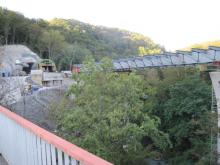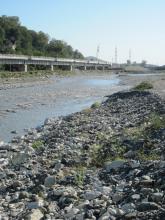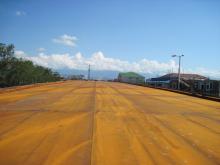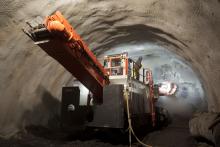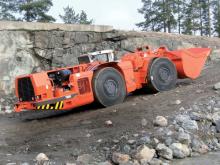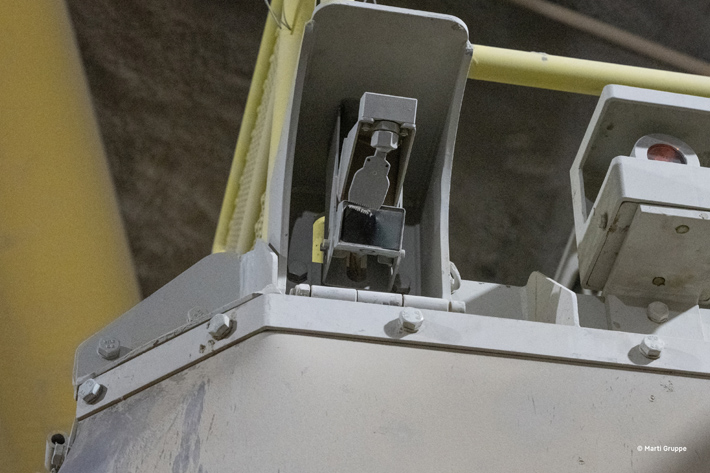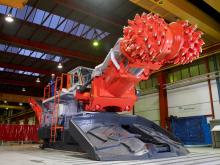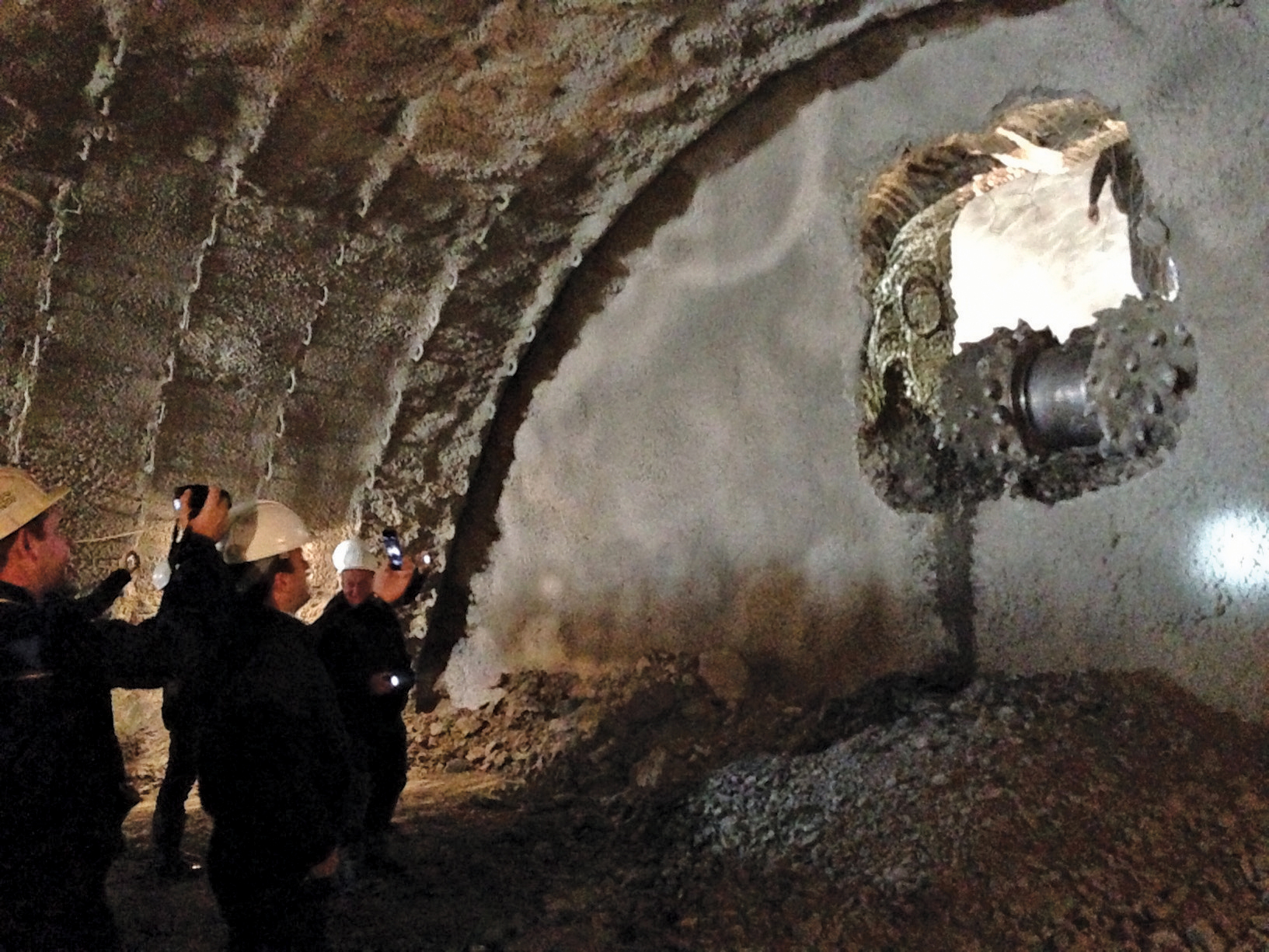
Sandvik Construction is among leading equipment manufacturers playing a key role in building a network of road and rail tunnels on one new and one existing transport route in and around the Russian coastal city of Sochi as part of a US$47.75 billion investment in preparations for the Sochi 2014 Winter Olympics. Guy Woodford reports
Some $20.05 billion (RUB 627bn) of the $47.75 billion (RUB 1.5trn) Russian government-led investment ahead of the Winter Olympics has been allocated for transport – including 260km of new roads in Sochi, situated on the east coast of the Black Sea. As a result of the new roads, the city’s traffic capacity will rise 1.8-2.5 times.
Currently, Sandvik tunnelling equipment is being used to build 12 underground road tunnels along the biggest of the new road links: Sochi’s $3.09 billion [RUB 100bn] Doubler of Kurortny Avenue. The new route will ease often heavy congestion on the existing four-lane (two -lanes each direction) Kurortny Street, and the Sochi bypass. Nine of the new highway’s 20km will pass underground, with all 12 road tunnels due for completion by October 2013. The road tunnels for this stage of the works range in length from 600m-1.45km.
“The first stage of tunnels [A148 motorway] ended around two years ago,” said Alexey Zubekhin, Sandvik Construction’s business line manager for tunnelling equipment in Russia. Of the second stage tunnel works, Zubekhin added, “Kurortny Street is the street going through all of Sochi. It’s the only longitudinal road for quite a long period. In order to reduce the amount of traffic jams, they [Russian government] decided to build another highway, the Doubler, which goes higher into the mountains around the city.”
Among the pieces of Sandvik equipment used on the Doubler of Kurortny Avenue construction in 2012 and so far in 2013 have been underground loaders, roadheaders, drill rigs, rock support drill rigs, exploration drills rigs, and breakers.
Key equipment for both stages of the Sochi 2014 underground road and rail tunnel works have included Sandvik tunnelling roadheaders MT720, MT520 and the MT360; Sandvik’s BR4099; BR3288; and BR1229 hydraulic breakers; the firm’s Axera T11 S 315C and T11 215 drills; the Robolt 08-250C and 07-3 rock bolting drill rigs; the DC120 hydraulic, self-propelled drilling unit; and the LH410 and TORO 1400 and 301 underground loaders.
The 115tonne MT520 tunnelling roadheader is claimed by Sandvik to be a new concept of a construction roadheader in the 100tonne class, based on easy exchangeable modules, selectable to adapt the MT520 basic machine to a vast variety of applications.
With an up to 8m cutting height and 10.8m maximum cutting width module, the MT520 is said to be highly suitable for large road tunnels.
For maximum cutting performance in soft ground, the cutter head can be exchanged easily. The full cutter motor power of 315kW is available both on the transverse and on the inline type cutter head.
An integrated dust extraction system caters for a healthy work environment for the tunnelling team.
The MT520 also has an onboard diesel power pack for quick and easy relocation.
The 57tonne MT360 model is said by Sandvik to be a very compact and heavy-duty roadheader within the 50tonne class. Designed to offer versatility for mining and tunnelling applications, the machine is suitable for hard-rock applications in all aspects of underground excavation.
The BR4099 and BR3288 hydraulic breakers used on the Sochi 2014 tunnels are said to have been designed using a revolutionary operating principle that combines stroke length, blow energy and Sandvik’s idle blow protector, allowing the breaker to be modified to match individual carriers and applications, improving hydraulic efficiency and safety.
With an operating weight of 3.38tonnes, the BR4099 has an impact rate of 400-560bpm. The BR3288 has an operating weight of 2.35tonnes and an impact rate of 370-630bpm.
Of the Sandvik equipment used by Sochi 2014 road and rail tunnel contractors, Zubekhin said, “In most of the [second stage] highway tunnels, commercial methods were used: mechanical cutting and road scanners. Only one - Tunnel 8 - is using only breakers and special drilling injections. It is the biggest tunnel and several other road scanner owners have been invited to finish it.”
Zubekhin said that the biggest challenge for contractors outside of completing both road and rail tunnel build stages on time has been the geology at the work sites. “There has been a mixture of argillite and plankton. Argillite is not very stable. They get very cracked and if you have some water, they [tunnels] can collapse easily. To combat this, different companies have found different solutions on how to stabilise the [tunnel] base and make a wide arch at the top of the tunnel.”
With Sandvik’s MT720, MT520 and MT360 roadheaders only generating 50 to 60 megapascals of pressure, Zubekhin said their use on the tunnel builds had enabled contractors to reduce water build-up from cracks in the argillite, stopping workers from sinking in mud.
“It took some time for some of the [contractor] companies to learn the skills to work well with the roadheaders. But our service engineers helped them and were always close to the job site. This is why we opened our office in Sochi,” said Zubekhin. “For Stroymontaz 14 [contractor], it was the first time they had used the MT520 [on the Doubler of Kurortny Avenue].”
Zubekhin said having the Sandvik Sochi office so close to the two-stage tunnel construction project, meant that a rare machine breakdown was fixed immediately.
“Some of the customers [contractors] were quite familiar with our machines, and bought the latest generations for this project. Others came to our factory and we took them to different job sites and showed them how the machines worked,” he added.
Asked about the significance of the huge transport infrastructure works around Sochi 2014 Winter Olympics, Zubekhin is quick to respond. “It is one of the flagship projects in Russia. A lot of people from all over the world will come to the Winter Olympics and see the results of what has been done. Unfortunately they won’t be able to compare it to how it was previously, but a big job has been done to make all the Olympic events more accessible.
“We are proud here in Russia that Sandvik was part of this huge project. A total of 44 Sandvik machines are at the same time working for the goal of making Sochi ready for the Winter Olympics as fast and efficiently as possible. When you mention the Winter Olympic project to [Russian] companies, everyone knows about it.”
Zubekhin said that as the huge Sochi 2014 transport infrastructure works nears its conclusion, attention is turning to the next giant transport infrastructure project: the 250km by 2020 expansion of the Moscow Metro. On completion, its 553km length will make it the third largest Metro in the world, after the Beijing and Shanghai metros.
“Due to our work with companies [contractors] in Sochi, the same companies are making requests for their work on the Moscow Metro. We will be sitting together and finding some good applications for our equipment on those works.”
Sochi 2014: The Key Facts
The Sochi 2014 Winter Olympics, officially the XXII Olympic Winter Games, or the 22nd Winter Olympics, will take place from 7-23 February 2014 in Sochi, Russia, with some events held in the resort town of Krasnaya Polyana.
More than 2,500 athletes will compete in 98 events covering 15 winter sports. Both the Olympic and Paralympic Games - held 7-16 March 2013 - are being organised by the Sochi Organising Committee (SOC).
Sochi was selected as the host city on 4 July 2007 during the 119th IOC Session in Guatemala City, triumphing over bids from Salzburg, Austria; and Pyeongchang, South Korea. The Sochi Olympics are the first Winter Olympics (and first Olympics altogether) for the Russian Federation, as the 1980 Summer Olympics in Moscow were in the Soviet Union. As well as the huge investment in transport infrastructure, preparations for Sochi 2014 include the building of new venues, and the modernising of the area’s telecommunications and power facilities. This will include the construction of a new Olympic Park by the Black Sea coast in the Imeretin Valley, with venues clustered around a central area. All venues in Krasnaya Polyana will also be new.
Sochi Olympic Park includes the Bolshoy Ice Dome – a 12,000 capacity arena which will host the Winter Olympic Ice Hockey Final, the 7,000 capacity Shayba Arena, which will also host ice hockey matches, the 8,000 capacity Adler Arena Skating Center for speed skating, and the Iceberg Skating Palace - a 12,000-seat venue for figure skating and short track speed skating. The Olympic Park also includes the Ice Cube Curling Centre, and the 40,000 capacity Fisht Olympic Stadium - which will stage the opening and closing ceremonies.
Krasnaya Polyana will house a Biathlon & Ski Complex –for biathlon, cross-country skiing and Nordic combined (cross-country skiing) events, the Freestyle Center and Snowboard Park – Freestyle skiing and Snowboarding, the Rosa Khutor Alpine Resort – Alpine skiing, the Sliding Center Sanki – Bobsleigh, Luge and Skeleton, the RusSki Gorki Jumping Center – Ski jumping and Nordic combined (ski jumping), and the Rosa Khutor Plateau Olympic Village.
MT720: Sandvik’s Gold Medal Roadheader
The primary roadheader used on the two-stage Sochi road and rail tunnel project was the Sandvik MT720. An innovative and extremely powerful boom-type roadheader in the 100tonne class, of particular use in Sochi was the MT720’s proven transverse cutting technology, which, due to its extended operation on the project, ensured high quality mechanised tunnelling in hard and abrasive rock formations.
In Sochi, the MT720 was said by Sandvik to have been able to deliver economical excavation of the rock through its optimised design and cutting power for low speed cutting.
Due to its robust, stabilised telescopic cutter boom, the cutting power is optimised without tramming, and straight face, even in high profiles. Additionally, the proportional load sensing hydraulic system optimises utilisation of energy; while the efficient dust suppression, and cutting tool cooling, is delivered by a high pressure pick flushing system. Any maintenance required, as well as assembly and disassembly, is aided by the modular design of the equipment.
As the power of the MT-series roadheaders is provided electro-hydraulically, enabling the equipment to emit no fumes, they are said to be perfect for such diverse applications as coal mining, mineral mining as well as underground construction projects such as Sochi.
Sandvik claims their ability to excavate the desired profile without causing harmful vibrations ensures that its roadheaders are prized both from an environmental and a safety perspective.
“All the Sandvik MT-series of roadheaders have proved their worth on the Sochi tunnelling project, as they are purpose designed and built for underground construction projects, “said a Sandvik spokesperson.
“With their powerful, geometrically optimised, transverse cutter heads, that are proven to give the best cutting performance in a wide range of rock formations, road tunnels, shaft sinking, and the excavation of underground caverns, the MT-series in general, and the MT720 in particular, have demonstrated their inherent flexibility in delivering results on a very tricky project, that possessed a great deal of challenges.”
F1 Russia after the Winter Olympics
As well as hosting the Winter Olympics in 2014, Sochi will also be welcoming all things fast and glamorous when it stages the first ever Formula One race in Russia.
The 5.9km, 16 turn Sochi International Street Circuit will weave around Sochi Olympic Park. Around 1.7km of the circuit length will take place on public roads.
The Sochi race, which is expected to take place in the summer of 2014, will be the first of seven annual F1 races taking place in Russia.

